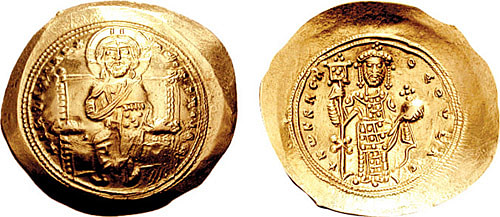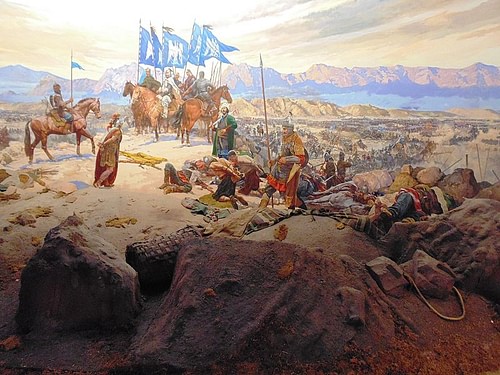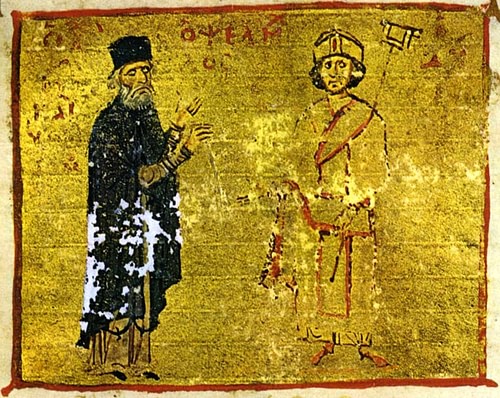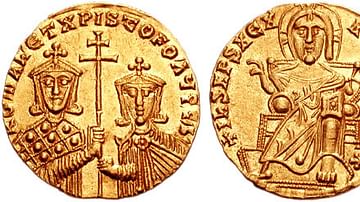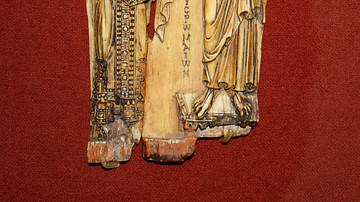
Romanos IV Diogenes ruled the Byzantine Empire from 1068 to 1071 CE. He was a military emperor, and his policies and campaigns served to shore up Byzantine defenses against the Seljuk Turks. However, in the aftermath of the Byzantine defeat at the Battle of Manzikert in 1071 CE, the civil war that emerged between the treacherous Doukas family and Romanos distracted and greatly weakened the Byzantine army and allowed the Turks to invade and conquer the key Byzantine territory of Anatolia.
Eudokia & Romanos
When Constantine X Doukas (r. 1059-1067 CE) died, his sons were still young. The older son, Michael VII (r. 1071-1078 CE), was 19 and could have ruled in his own right. However, Michael seemed to have had little interest in ruling and let his mother, Constantine's widow Eudokia Makrembolitissa, be the de facto ruler of the Byzantine Empire. On Constantine's death, Eudokia had sworn on the Trinity, prophets, apostles, saints, and everyone else who was Christian and holy that she would not even think about remarrying. Constantine had ordered this to prevent a figure such as Romanos I Lekapenos (r. 920-944 CE) or Nikephoros II Phokas (r. 963-969 CE) from emerging as a 'protector' of his sons, which would be especially easy if someone married Eudokia.
However, the pressures of rule caught up with Eudokia. The raids by Seljuk Turks intensified, and one marauding band under the Turkish general Afshin sacked the major central Anatolian city of Caesarea, and Byzantine defenses were still weak from Constantine's stingy military financing policy. A general had to become emperor if the Byzantines would be saved from these dangerous menaces.
So entered Romanos Diogenes. Romanos was from a prominent military family, the son of Constantine Diogenes, who had been an important general before he was imprisoned by Romanos III Argyros (r. 1028-1034 CE) for conspiring with the then princess Theodora (later empress in her own right, r. 1055-1056 CE). Romanos Diogenes was the dux, or duke, of Serdica, but he had plotted with Hungary and was sentenced to death. However, Eudokia and several of the judges thought they had found the emperor the Byzantine Empire needed. Given that the sources describe Romanos as handsome and muscular, it is even possible that Eudokia had fallen for the general. On January 1, 1068 CE, Romanos married Eudokia and became emperor, promising to protect the rights of the Doukai princes, much like Nikephoros II Phokas promised to protect the Macedonian princes a century earlier. Almost everyone now accepted Romanos, but Constantine's brother, John Doukas, saw the potential danger to his brother's dynasty. His enmity for Romanos would lead to problems later in Romanos' reign.
To the East
Constantine X's reign had left the eastern frontier in a disastrous state. No major Byzantine army had been deployed there for over a decade, and the steady incursions of the Seljuk Turks highlighted Byzantine feebleness. Isaac I Komnenos (r. 1057-1059 CE) might have been able to right the ship when the first signs of decline were appearing, but under Constantine, the Byzantine Empire measurably slipped. Isaac had ruled alone, while Romanos now had to share power with the Doukai and combat the jealousies of John Doukas.
When Romanos headed east to rally the troops, he found them in a pitiful state. Contemporary historian and government minister Michael Attaleiates recounted that “it was something to see the famous units and their commanders now composed of just a few men, and these bent over by poverty and lacking proper weapons and war horses” (Attaleiates 103). Romanos defeated a raid on Pontus along the Black Sea before heading into Syria to counter the main thrust of Seljuk Turk interest.
The Emirate of Aleppo had escaped Byzantine vassalage sometime after the reign of Romanos III Argyros, but the ruling Mirdasid dynasty continued to fight among itself and remained weak. The Seljuk Turks had started to use weak Aleppo as a staging ground to attack the important Byzantine province around the major city of Antioch, and they were more interested in expanding into Syria than further north. Romanos immediately captured the city of Hierapolis (modern Manbij) on the border of northern Syria, but his forces were blockaded by Turkish and local Aleppo forces before routing the Muslim forces the next day. Romanos then took the city of 'Artah across from Antioch before returning to Constantinople. While it seemed his campaign was a success, the Turkish general Afshin had slipped through Byzantine defenses and sacked the major central Anatolian city of Amorium. The mobility of the Seljuk Turks was perhaps their greatest asset, and it made it difficult for the Byzantines to keep up. Knowing he could do nothing, for the time being, Romanos continued on home to Constantinople.
Romanos' campaign was still considered a success: Syria had been partially restrained, and Byzantine morale was starting to recover. But instead of being able to follow up on this success immediately, Romanos had to face the rebellion of Roger Crépin. Roger was a Norman mercenary, and the Byzantines had hired him and his band to fight under their banner in Armenia. Roger rebelled and seized the tax reserves in Armenia. He fought off five combined Byzantine armies before eventually surrendering to Romanos. However, his mercenaries continued to raid other parts of Byzantium. While the Byzantine army was mostly composed of native soldiers from the reigns of Heraclius (r. 610-641 CE) through Basil II (r. 976-1025 CE), the emperors had increasingly turned to mercenaries. With the old system of domestic recruitment in shambles, Romanos had no choice but to recruit mercenaries as well. They tended to be highly disloyal and were quite expensive. Roger was no exception but actually the rule. His rebellion was the first sign of the fight to come: Western Europeans and Turks fighting for the ever-shrinking corpse of Byzantium.
The next two years entailed Romanos chasing various bands of Turks around Anatolia. He met with mixed success: he would defeat one band only to have another nearly simultaneously sack a city somewhere else in the Byzantine Empire. The areas around Melitene became so devastated that Romanos could not camp an army there. Although by resisting the Turks Romanos was doing more than Constantine X, the end result was a war of attrition akin to those earlier border wars between the Byzantines and Muslims between the 7th and 10th centuries CE.
Troubles at Home
While Romanos was out campaigning, Eudokia had born him one son, Leo, and another, Nikephoros, would come in the next year. This posed obvious problems to the Doukai. Although Nikephoros II had married Basil II and Constantine VIII's mother Theophano, she did not bear him any children so there was no direct threat to Basil and Constantine eventually becoming emperor. In comparison, there were now sons of both Constantine and Romanos and both had viable claims to the Byzantine throne.
To counter the Doukai, Romanos established ties with the family of Isaac I Komnenos, the Komnenoi. Romanos appointed Manuel Komnenos, the nephew of Isaac I, as the commander of that year's expedition against the Turks while he stayed home. However, the Turks defeated Manuel at Sebasteia and captured him. Although Arisighi, a rebellious brother-in-law of the Turkish sultan Alp Arslan (r. 1063-1072 CE), let Manuel go. Arisighi also provided information on Seljuk tactics to Romanos, which were useful for the coming battles with Alp Arslan.
The alliance between the Komnenoi and Romanos versus the Doukai contributed to the popular modern historical belief that there was a competition between the elite of the capital and the military elite of the provinces. However, this is not entirely accurate. While the Doukai were the reigning dynasty, the family had its start as provincial elites just like Romanos and the Komnenoi. A more accurate description would be that there were internecine rivalries and alliances between the elites, no matter where they were based, to seize or maintain their hold on power.
Battle of Manzikert
In 1070 CE, Romanos had several forts constructed in Anatolia to better fortify the Byzantine Empire's borders. Following up on his success in Syria and at least dissuading Turks from raiding deep into the interior of Anatolia, Romanos decided it was time to defeat the Turks where they had first invaded his empire, in Armenia. Romanos gathered an army and headed off towards the Armenian provinces.
Meanwhile, Alp Arslan, the sultan of the Seljuk Turks, had failed to take Edessa from the Byzantines and Aleppo from its Mirdasid emirs. But as soon as he heard that Romanos was moving toward Armenia, he gathered his army and headed there too.
Upon arriving in Armenia, Romanos thought that he could take the city of Manzikert with a smaller force, and so sent the larger and superior part of his army to Khliat under Joseph Tarchaneiotes to take it as well. Romanos did take Manzikert with ease, but by that time Alp Arslan was in the vicinity. Romanos, believing it was only a smaller force, sent a small force under Nicephorus Bryennius to fend the Turks off. Diogenes sent in reinforcements under Nikephoros Basilakes, but they followed Alp Arslan's troops, feigning a retreat, too far and were tricked and captured. Romanos attempted another sally, but when the Turks started firing arrows everyone fled for cover. The Byzantines eventually fired back, and the Turks formed lines around the Byzantine camp, effectively cutting them off from the larger Byzantine force under Tarchaneiotes and putting the emperor and the Byzantines in a very dangerous position.
Alp Arslan sent envoys to negotiate peace, but Romanos instead decided to settle things in battle, believing that Tarchaneiotes' forces wouldn't arrive in time. Romanos did push the Turks back, but when he gave a signal to regroup at camp when they had advanced too far, the signal was misinterpreted by soldiers at the rear as a sign that the emperor had fallen in battle. According to some, the rumor that Romanos had been slain in battle was started by Andronikos Doukas, the son of John Doukas. He obviously had an interest in getting Romanos out of the way. The forces in the vanguard with Romanos were left high and dry and were attacked with renewed vigor by the Turks. Romanos had made the mistake of splitting his army and not maintaining active scouts to notify him that Alp Arslan was approaching. He paid the price for it; while Andronikos retreated, Romanos was captured by Alp Arslan.
Emperor No More
In the aftermath of Manzikert, it was unclear to the Byzantines whether Romanos was dead or alive. Alp Arslan asked Romanos what he would do to him if their positions were reversed. Alp Arslan respected Romanos' candor when he said he would have had him cruelly killed. Romanos concluded a treaty with Alp Arslan, suing for peace in exchange for ceding parts of Armenia, tribute, and a marriage alliance. In exchange, he was released along with his men.
Manzikert had not been a disaster in pure military terms, since the majority of the army under Tarchaneiotes was intact, as were the majority of troops that had retreated from Romanos' vanguard when they thought he was dead. However, the most senior military leaders, such as Andronikos, rushed to Constantinople to play kingmaker in the capital. So the Byzantine armies, while intact, were leaderless. The coffers of Byzantium were bare. Romanos, although alive and back in his empire, had lost his military prestige at Manzikert. He had been brought in to provide military victory, but he had failed.
The Doukai lost no time in declaring Romanos deposed. John and Andronikos also deposed Eudokia since she was the one who had brought Romanos on as emperor and was the mother of his children. Michael VII Doukas was declared the sole emperor. John's other son, Constantine Doukas, and Roger Crépin, the Norman mercenary who had been imprisoned by Romanos for rebelling, led an army into Anatolia to face off against Romanos' supporters. Constantine defeated Romanos' supporters under Theodoros Alyates and had him blinded. Romanos retreated to Cappadocia, where he was reinforced by the dux of Antioch, Chatatourios. They then retreated again to the mountains of Cilicia. While Cilicia would provide the foundation for a state under Philaretos, the Crusaders, and Armenians, it would not do so for Romanos.
The Doukai offered him amnesty, but Romanos refused to give up his imperial title. Andronikos and Roger defeated Chatatourios in battle and surrounded Romanos at Adana. Romanos failed to obtain Seljuk help and surrendered in exchange for a promise from the Doukai that no harm would come to him if he became a monk. However, the Doukai ineptly blinded Romanos, and he died from his wounds on August 4, 1072 CE.
No matter whether John or Michael VII was behind the blinding, or even if it were for the good of the Byzantine Empire, as the contemporary historian and minister Michael Psellos claimed, it discredited Michael's regime at a time when it could ill-afford to suffer any setbacks. It was not Manzikert itself that allowed the Turks to conquer Anatolia; instead, it was the civil war caused by the Doukai. Regardless of their actions, the Turks would have seen the weakness of the eastern Byzantine frontier after Manzikert. What would have been just a setback became a decisive blow against the Byzantine Empire and the end of its control over all of Anatolia, its key territory since the reign of Heraclius in the 7th century CE.
Tragic Memory
Attaleiates described Romanos as a quintessential tragic hero. His reign was a failure not because of Romanos himself, but because of circumstances. He had tried his best and did a relatively good job up until Andronikos' betrayal at Manzikert. Many other emperors had been deposed, but perhaps none elicited sorrow like Romanos. The consequences of the civil war and Romanos' death were catastrophic to the Byzantine Empire, and it would never recover from the damage caused by the jealousy of the Doukai.

